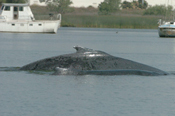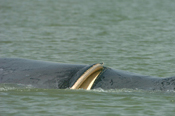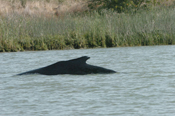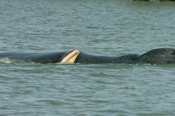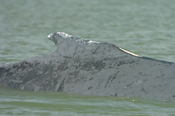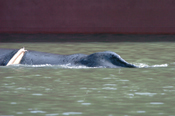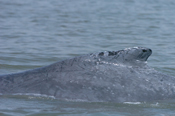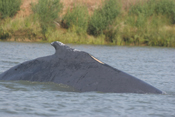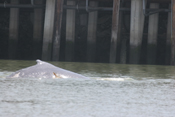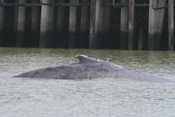Humpback Whales in the Sacramento River, May 2007
Update: May 18, 2007
For the most current information, please check NOAA's Incident News website.
Timeline of the Event
- On Wednesday, May 9th, two whales were seen off of Benicia. One animal was reported as having a white "tag" on its back.
- On Sunday, May 13th, the Solano County (California) Sheriff's Department began receiving reports of at least two whales in the Sacramento River Delta Area near Rio Vista.
- On Monday, May 14th, the Solano Co. Sheriff's Department contacted NOAA Fisheries to request assistance. NOAA Fisheries coordinated with the stranding network to send a whale biologist to visually confirm that there were two (2) humpback whales. The US Coast Guard Station Rio Vista also provided assistance by issuing a warning for vessels to maintain at least a 100 yard perimeter around the whales, and for aircraft to maintain a minimum of 1,000 ft elevation, which corresponds with NMFS guidelines for responsible large whale viewing practices.
- On Tuesday, May 15th, NOAA Fisheries deployed more biologists and a marine mammal veterinarian to obtain a health assessment of the animals. They searched the area where the whales were last seen on Monday, but could not relocate them. Tuesday evening, they were resighted by a news traffic helicopter near/in the deep water shipping channel just south of Sacramento. However, the time of day prevented any on-water response.
- On Wednesday, May 16th, the whales were relocated by news helicopters just south of the turning basin in Sacramento. Biologists and veterinarians were on scene and completed a visual health assessment. The animals spent all day swimming around the turning basin.
- On Thursday, May 17th, the teams spent all day on the water with the whales. One boat with acoustic equipment broadcast humpback whale feeding calls from at least 300m from the animals, while a second boat stayed closer to the animals to monitor their behavior. Several large press conferences were also held. The animals showed no reaction to the playbacks. On Thursday night, a conference call was held with all of the on-water participants and other marine mammal experts from around the US to discuss the results and future plans. Response triggers and an action plan for the next few days were formulated.
- On Friday, May 18th, the teams plan to try again to lure the animals out of the turning basin and back towards the ocean using acoustic calls of feeding humpbacks. After the conference call last night, some changes to the calls (frequency, volume, and type of call) will be made to attempt to provoke a response from the whales.
Additional Background Information
- The pair has been confirmed to be a cow/calf pair. Some questions remain as to the exact age of the calf and whether it is still maternally nutritionally dependent (nursing). The best guess of the experts is that it is a young of the year calf that is in very good body condition, and quite large for its age.
- Contrary to earlier reports, neither animal is entangled. Both animals have been confirmed to be injured. The adult cow has a straight laceration on her dorsal surface that is estimated to be 2-3' long and 6" deep. The cut does not extend into the muscle layer, and no blood has been seen from this wound. A second superficial cut can be seen just before the dorsal fin. Veterinarians do not believe that this animal is in any immediate danger from this wound.
- The calf's wound is a lateral (on its side) laceration that is about 2/3 of the way down the body. It has only been seen infrequently, because that part of the animal typically remains underwater, except when the animal strongly arches its back. This cut appears to be deeper, and is believed to extend into the muscle layer and may be bleeding.
- The primary concern for the response at this time is to ensure that the animals are not harassed and stressed by boats, aircraft, and people. The whale's health status must be assessed to determine if there is an underlying cause to help explain why they may have entered the river, and what their prognosis is.
- Responding to these animals is a multi-agency, multi-organization effort, including NOAA Fisheries, local law enforcement, the Coast Guard, and our partners in the marine mammal stranding network (The Marine Mammal Center, Cascadia Research Collective, Moss Landing Marine Laboratories, Alaska Whale Foundation, and others).
General Background Information on Humpback Whales
- Humpback whales (Megaptera novanangliae) migrate twice a year along the coast of California from their breeding grounds off of Central America and Mexico to their feeding grounds off California, Oregon, Washington and Canada.
- At this time of year, humpbacks are making their northward migration from the breeding grounds to the feeding grounds.
- This stock of humpback whales is called the Eastern North Pacific stock. In the most recent stock assessment report issued by NOAA, the minimum population estimate for this stock is 1,158 animals. The population estimate for all humpback whales in the North Pacific is approximately 6,000 animals.
- Humpback whales are listed as Endangered under the Endangered Species Act and depleted under the Marine Mammal Protection Act throughout their range.
- Humpback whales are individually identifiable by unique markings on their tail flukes, similar to a human fingerprint. Many researchers study individual humpbacks for much of their lives.
- Like all marine mammals, humpback whales are protected in the United States under the Marine Mammal Protection Act, which makes it illegal to "take" marine mammals by harassment, hunting, capturing, killing, or attempting any of these activities without special authorization.
- A humpback whale named "Humphrey" similarly swam up the Sacramento River in 1985, reaching Rio Vista (where the whales were observed on Monday). He was successfully guided back to the Pacific Ocean using a "sound net" in which people in a flotilla of boats made unpleasant noises behind the whale by banging on steel pipes, a Japanese fishing technique known as "oikami." At the same time, the attractive sounds of humpback whales preparing to feed were broadcast from a boat headed towards the open ocean. Humphrey returned to San Francisco Bay a second time in 1990, and became stranded on a mudflat near 3 COM Park. He was successfully pulled off the mudflat into deeper water with Coast Guard assistance, and again guided back to the Pacific Ocean. Since leaving the San Francisco Bay in 1990, Humphrey has been seen only once, at the Farallon Islands in 1991.
More Info
The latest updates are posted on NOAA's Incident News website.
If you have additional questions or comments, please contact Sacramento.Whales@NOAA.gov. A marine biologist will be reviewing each and every submission, and relevant information will be passed to the rescue team. However, we may not be able to respond to each suggestion individually. Please be patient as we are receiving a high volume of emails. Thank you for your support and concern.
